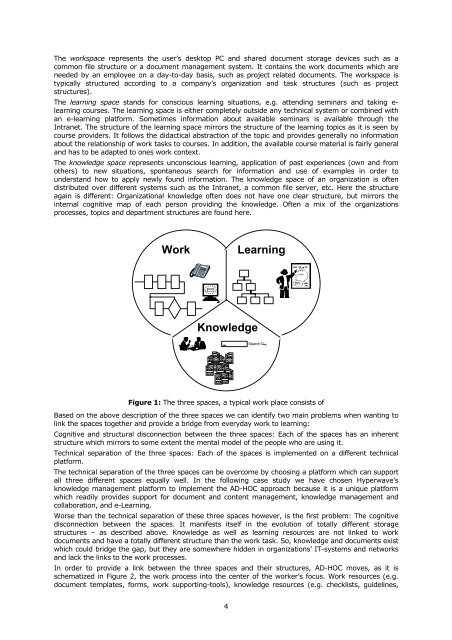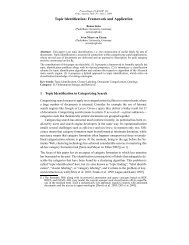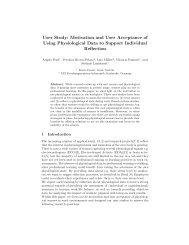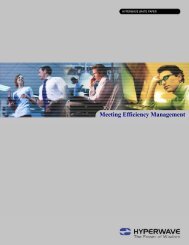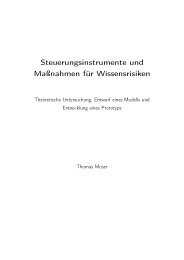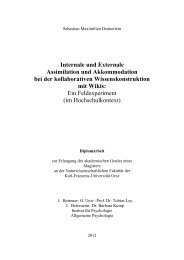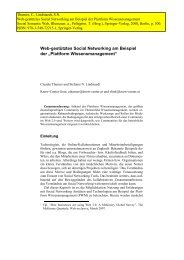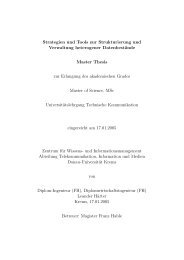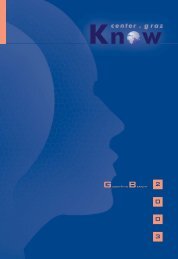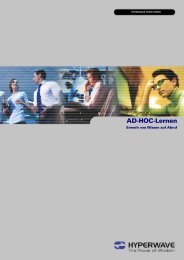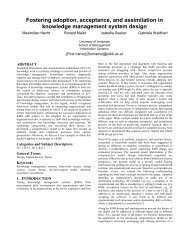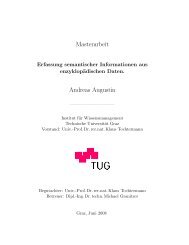AD-HOC Learning - Acquiring Skills on Demand - Know-Center
AD-HOC Learning - Acquiring Skills on Demand - Know-Center
AD-HOC Learning - Acquiring Skills on Demand - Know-Center
Create successful ePaper yourself
Turn your PDF publications into a flip-book with our unique Google optimized e-Paper software.
The workspace represents the user’s desktop PC and shared document storage devices such as a<br />
comm<strong>on</strong> file structure or a document management system. It c<strong>on</strong>tains the work documents which are<br />
needed by an employee <strong>on</strong> a day-to-day basis, such as project related documents. The workspace is<br />
typically structured according to a company’s organizati<strong>on</strong> and task structures (such as project<br />
structures).<br />
The learning space stands for c<strong>on</strong>scious learning situati<strong>on</strong>s, e.g. attending seminars and taking elearning<br />
courses. The learning space is either completely outside any technical system or combined with<br />
an e-learning platform. Sometimes informati<strong>on</strong> about available seminars is available through the<br />
Intranet. The structure of the learning space mirrors the structure of the learning topics as it is seen by<br />
course providers. It follows the didactical abstracti<strong>on</strong> of the topic and provides generally no informati<strong>on</strong><br />
about the relati<strong>on</strong>ship of work tasks to courses. In additi<strong>on</strong>, the available course material is fairly general<br />
and has to be adapted to <strong>on</strong>es work c<strong>on</strong>text.<br />
The knowledge space represents unc<strong>on</strong>scious learning, applicati<strong>on</strong> of past experiences (own and from<br />
others) to new situati<strong>on</strong>s, sp<strong>on</strong>taneous search for informati<strong>on</strong> and use of examples in order to<br />
understand how to apply newly found informati<strong>on</strong>. The knowledge space of an organizati<strong>on</strong> is often<br />
distributed over different systems such as the Intranet, a comm<strong>on</strong> file server, etc. Here the structure<br />
again is different: Organizati<strong>on</strong>al knowledge often does not have <strong>on</strong>e clear structure, but mirrors the<br />
internal cognitive map of each pers<strong>on</strong> providing the knowledge. Often a mix of the organizati<strong>on</strong>s<br />
processes, topics and department structures are found here.<br />
Work <str<strong>on</strong>g>Learning</str<strong>on</strong>g><br />
<strong>Know</strong>ledge<br />
4<br />
Search<br />
Figure 1: The three spaces, a typical work place c<strong>on</strong>sists of<br />
Based <strong>on</strong> the above descripti<strong>on</strong> of the three spaces we can identify two main problems when wanting to<br />
link the spaces together and provide a bridge from everyday work to learning:<br />
Cognitive and structural disc<strong>on</strong>necti<strong>on</strong> between the three spaces: Each of the spaces has an inherent<br />
structure which mirrors to some extent the mental model of the people who are using it.<br />
Technical separati<strong>on</strong> of the three spaces: Each of the spaces is implemented <strong>on</strong> a different technical<br />
platform.<br />
The technical separati<strong>on</strong> of the three spaces can be overcome by choosing a platform which can support<br />
all three different spaces equally well. In the following case study we have chosen Hyperwave’s<br />
knowledge management platform to implement the <str<strong>on</strong>g>AD</str<strong>on</strong>g>-<str<strong>on</strong>g>HOC</str<strong>on</strong>g> approach because it is a unique platform<br />
which readily provides support for document and c<strong>on</strong>tent management, knowledge management and<br />
collaborati<strong>on</strong>, and e-<str<strong>on</strong>g>Learning</str<strong>on</strong>g>.<br />
Worse than the technical separati<strong>on</strong> of these three spaces however, is the first problem: The cognitive<br />
disc<strong>on</strong>necti<strong>on</strong> between the spaces. It manifests itself in the evoluti<strong>on</strong> of totally different storage<br />
structures – as described above. <strong>Know</strong>ledge as well as learning resources are not linked to work<br />
documents and have a totally different structure than the work task. So, knowledge and documents exist<br />
which could bridge the gap, but they are somewhere hidden in organizati<strong>on</strong>s’ IT-systems and networks<br />
and lack the links to the work processes.<br />
In order to provide a link between the three spaces and their structures, <str<strong>on</strong>g>AD</str<strong>on</strong>g>-<str<strong>on</strong>g>HOC</str<strong>on</strong>g> moves, as it is<br />
schematized in Figure 2, the work process into the center of the worker’s focus. Work resources (e.g.<br />
document templates, forms, work supporting-tools), knowledge resources (e.g. checklists, guidelines,


